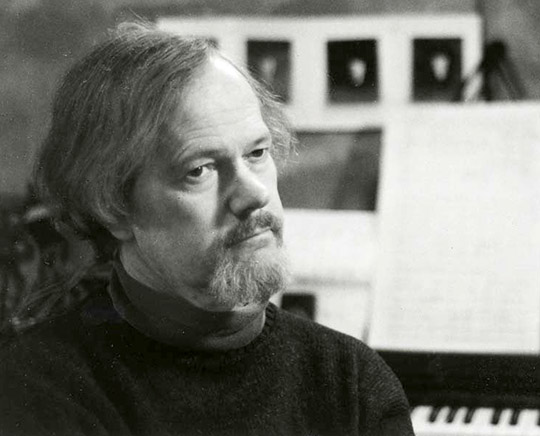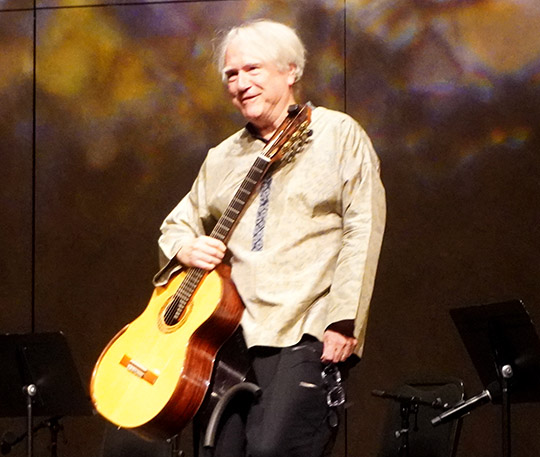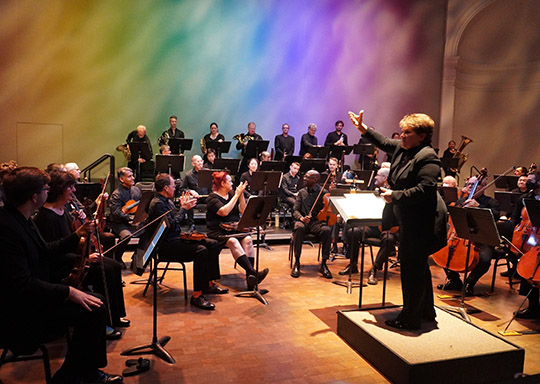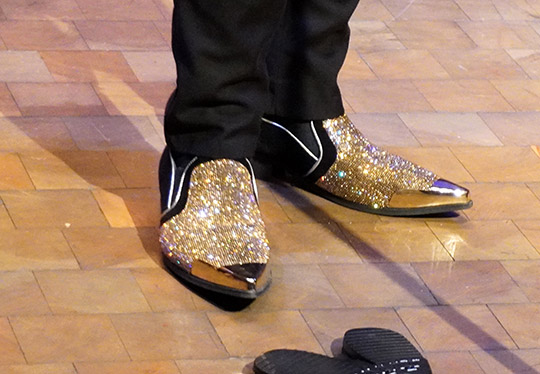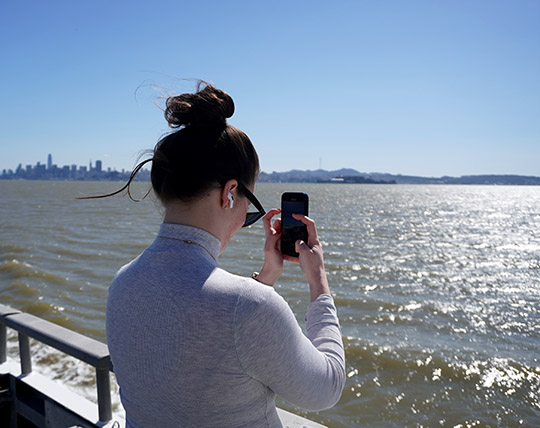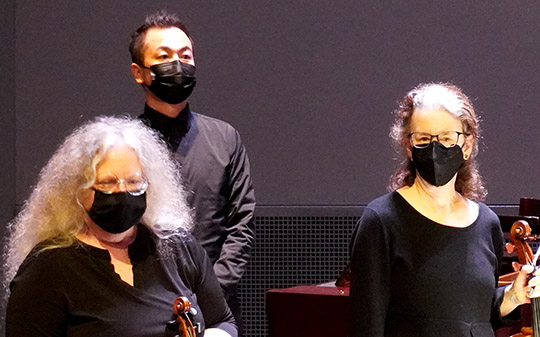Shakespeare's Romeo and Juliet has survived theatrical adaptations set in different centuries and cultures, and been used as symphonic inspiration for Berlioz and Tchaikovsky, not to mention cinematic treatments that range from directors Franco Zeffereli to Baz Luhrmann.
My favorite adaptation, however, is the 1936 full-length ballet by Sergei Prokofiev that he wrote after returning to Russia because of a mixture of homesickness and promises from the government of a steady income. This turned out to be a mistake personally and politically in Stalin's Soviet Union, but he composed great music, notably Romeo and Juliet. The musical score is vivid, pictorial, grotesque, romantic, and filled with memorable tunes. (Pictured above in production photos by Lindsay Thomas are Angelo Greco and Jasmine Jamison as the titular young couple.)
As a very young man in the 1970s, I discovered Romeo and Juliet when Michael Smuin was "co-director" of the company, and he choreographed a terrific, lively production that I saw from standing room multiple times because hearing the exciting, theatrical music with a live orchestra and passionate dancers was such a treat.
Helgi Tomasson became the new Artistic Director of the SF Ballet in 1985 and he created a lavish new production in 1994 which was, for the most part, deadly dull. The original play is all about sex and puns about maidenhood and the death of multiple youths, but this version was bloodless.
The Smuin production was sleek, minimalist, and emphasized boys engaging in family gamg war on the streets with swords while taking flying leaps in the air. Tomasson's production features good swordfighting scenes, but his public squares of Verona are a mess. Two "Harlots" are invented for the boys to dance with over and over again, which doesn't make much sense, and poor Romeo is usually impossible to distinguish from his friends or the other "happy villagers."
The most striking music in the ballet is for the Capulet's masked ball, where Romeo and Juliet meet. It sounds like a fascist march mixed with a waltz and it's bizarrely shocking to hear in context. The costumes were gorgeous but were identical in this scene which made the sneaking in of rogue Montagues even more nonsensical than usual.
None of this mattered that much because the music is so stirring and the dancers in the company right now are superb. What was even lovelier, two of the stars of the Smuin production are still performing with the company in "character" roles. Jim Sohm as Friar Laurence in this production was a handsome, sensitive Romeo in Smuin's version. Anita Paciotti (above) is now the Nurse while stealing the show decades ago at every performance when she was Lady Capulet going publicly mad with grief over her nephew Tybalt's dead body. And Prokofiev gave her the percussion and screaming brass music to accompany her over-the-top moment at the end of Act Two.
Tomasson retired last year, although he programmed this year's season, which has been remarkably successful, a mixture of new work and classics with consistently exciting dancing on the part of the company he built. There has already been intimations of more backstage warfare during the transition to the new Artistic Director Tamara Rojo, whose adventurous first season was just announced followed the next day by the resignation of her Executive Director. I wish her the best and hope she will give us a new Romeo and Juliet
There are more performances throughout this weekend, and it's highly reommended. Click here for tickets.
Thursday, April 27, 2023
Wednesday, April 19, 2023
Ingram Marshall Memorial Concert
San Francisco Performances hosted a memorial concert last Saturday for the American composer Ingram Marshall (above), who died last May at the age of 80. There was already a memorial concert last October at New York Public Radio's small Greene Space and the Yale School of Music in November with various musicians who Marshall had written music for. (There's a good recording on YouTube of the New York concert, click here.) Marshall was bicoastal, in that he was born and raised in New England, was a professor and an important, inventive composer on the West Coast for over 25 years, before returning home to New England where he continued composing and teaching.
The Left Coast memorial concert in San Francisco involved most of the same artists as New York, but this was a more extravagant affair, beginning with the beauty of Herbst Theater in the Veterans Building as a memorial stage. Pianist Sarah Cahill was the hostess, interviewing performers about the music they were playing while the stage would be reset for the next musical ensemble.
Ben Verdery played the 1999 Soe-pa for solo guitar and a looping laptop which had been written for him, and it was the first of a series of works involving live and prerecorded music intertwining. Marshall had been composing for this form using tape in the pre-digital age and what is striking about all those pieces is how difficult it is to distinguish the live from the electronic. The sonic effect is not so much a duet as a unified collage.
Sarah Cahill played the gorgeous piano piece Marshall had written for her in 2001, Authentic Presence. It is mostly meditative and semi-minimalist in style, but midway it explodes into a huge flowerburst of notes, which sounded like it could be augmented with a prerecorded track, but Cahill confirmed it was her fingers alone.
The work that brought Marshall some fame was the 1981 Fog Tropes, written for a brass sextet interacting with a tape the composer had created of San Francisco Bay foghorns. It premiered in 1981 at a New & Unusual Concert programmed by John Adams, Marshall's composer friend and colleague. Soon after it was played at Davies Hall with Edo de Waart conducting, which I happened to stumble into. The piece sounded wistful, mysterious, and very cool. Last Saturday the work was conducted by Edwin Outwater with the SF Conservatory of Music Brass Sextet, who all sounded top-notch.
After intermission, we heard the 1993 Dark Waters, written for woodwind legend Libby Van Cleve who played the English Horn in tandem with a fragmented, sampled old recording of Sibelius's The Swan of Tuonela. The Finnish version of the River Styx is Tuonela, where the dead cross the water from the land of the living to the shore of the dead. Again, the work sounded so cohesive that it was impossible at times to know what was live and what was tape.
The final work was Flow, for piano and chamber orchestra, written for Marshall's former student Timo Andres and his old colleague John Adams.
On Saturday, Adams conducted the buoyant 15-minute semi-concerto in a wonderful performance from a pickup SF Conservatory chamber orchestra, and Timo Andres seemed to be having a ball as the soloist. Most of Marshall's music I have heard has a strong streak of melancholy running through it so it was a pleasure to hear a happier strain.
What came across from the anecdotes about Marshall was how generous he was with his attention, making one feel as if they were the most important person in the world. "Sampled" from Ms. Van Cleve's Facebook page, the above after-performance photo is of Timo Andres, Libby Van Cleve, Ben Verdery, John Adams, and Sarah Cahill. They did their friend justice.
The Left Coast memorial concert in San Francisco involved most of the same artists as New York, but this was a more extravagant affair, beginning with the beauty of Herbst Theater in the Veterans Building as a memorial stage. Pianist Sarah Cahill was the hostess, interviewing performers about the music they were playing while the stage would be reset for the next musical ensemble.
Ben Verdery played the 1999 Soe-pa for solo guitar and a looping laptop which had been written for him, and it was the first of a series of works involving live and prerecorded music intertwining. Marshall had been composing for this form using tape in the pre-digital age and what is striking about all those pieces is how difficult it is to distinguish the live from the electronic. The sonic effect is not so much a duet as a unified collage.
Sarah Cahill played the gorgeous piano piece Marshall had written for her in 2001, Authentic Presence. It is mostly meditative and semi-minimalist in style, but midway it explodes into a huge flowerburst of notes, which sounded like it could be augmented with a prerecorded track, but Cahill confirmed it was her fingers alone.
The work that brought Marshall some fame was the 1981 Fog Tropes, written for a brass sextet interacting with a tape the composer had created of San Francisco Bay foghorns. It premiered in 1981 at a New & Unusual Concert programmed by John Adams, Marshall's composer friend and colleague. Soon after it was played at Davies Hall with Edo de Waart conducting, which I happened to stumble into. The piece sounded wistful, mysterious, and very cool. Last Saturday the work was conducted by Edwin Outwater with the SF Conservatory of Music Brass Sextet, who all sounded top-notch.
After intermission, we heard the 1993 Dark Waters, written for woodwind legend Libby Van Cleve who played the English Horn in tandem with a fragmented, sampled old recording of Sibelius's The Swan of Tuonela. The Finnish version of the River Styx is Tuonela, where the dead cross the water from the land of the living to the shore of the dead. Again, the work sounded so cohesive that it was impossible at times to know what was live and what was tape.
The final work was Flow, for piano and chamber orchestra, written for Marshall's former student Timo Andres and his old colleague John Adams.
On Saturday, Adams conducted the buoyant 15-minute semi-concerto in a wonderful performance from a pickup SF Conservatory chamber orchestra, and Timo Andres seemed to be having a ball as the soloist. Most of Marshall's music I have heard has a strong streak of melancholy running through it so it was a pleasure to hear a happier strain.
What came across from the anecdotes about Marshall was how generous he was with his attention, making one feel as if they were the most important person in the world. "Sampled" from Ms. Van Cleve's Facebook page, the above after-performance photo is of Timo Andres, Libby Van Cleve, Ben Verdery, John Adams, and Sarah Cahill. They did their friend justice.
Saturday, April 15, 2023
Bay Area Rainbow Symphony with Samuel Vargas
The Bay Area Rainbow Symphony is an amateur orchestra formed in 2008 that is amazingly ambitious and accomplished. Two weeks ago they offered a concert at the small, round Taube Atrium Theater on the top floor of the Veterans Building in San Francisco. The opener was Arnold Schoenberg's 1945 Fanfare for a Bowl Concert on Motifs of Die Gurrelieder. I had never heard of the two-minute piece for brass and percussion before, so that was a treat, although the exposed brass section was having intonation issues.
This was followed by the Venezuelan violin soloist Samuel Vargas in Florence Price's 1952 Violin Concerto No. 2 for Violin and Orchestra. This was another presumably lost work by the recently revived composer that was discovered in 1975 in an abandoned Illinois home she once owned.
The orchestra accompanied Vargas beautifully in the 15-minute concerto, with the wind section sounding particularly fine, including clarinets Gene Nakajima (photo above) and Ritchie Iu, along with principal flute David Latulippe.
Vargas is a spectacularly good violinist, and his onstage charm was as sparkly as the boots he wore.
Vargas and the orchestra continued with a familiar warhorse, Camille Saint-Saëns's 1863 Introduction and Rondo Capriccioso, in the best live performance I have heard anywhere of the piece. Vargas returned after intermission for an encore of his own composition based on Venezuelan folk tunes where he fiddled, whistled, and sang exquisitely. If you ever get a chance to see him, do so.
Then the fine conductor Dawn Harms launched the orchestra into Tchaikovsky's Symphony No. 3 in D Major "Polish". It is a blustery five-movement work mostly known from Balanchine's Jewels ballet, where the symphony minus the first movement provides the music for Diamonds.
The group may have bitten off more than they could chew with this 45-minute symphony but it was fun sitting in what felt like the laps of the orchestra for the big, rambunctious piece. The group's next concert will be held at the SF Conservatory on June 10th when they will tackle Bernstein's Symphony No. 2 Age of Anxiety.
This was followed by the Venezuelan violin soloist Samuel Vargas in Florence Price's 1952 Violin Concerto No. 2 for Violin and Orchestra. This was another presumably lost work by the recently revived composer that was discovered in 1975 in an abandoned Illinois home she once owned.
The orchestra accompanied Vargas beautifully in the 15-minute concerto, with the wind section sounding particularly fine, including clarinets Gene Nakajima (photo above) and Ritchie Iu, along with principal flute David Latulippe.
Vargas is a spectacularly good violinist, and his onstage charm was as sparkly as the boots he wore.
Vargas and the orchestra continued with a familiar warhorse, Camille Saint-Saëns's 1863 Introduction and Rondo Capriccioso, in the best live performance I have heard anywhere of the piece. Vargas returned after intermission for an encore of his own composition based on Venezuelan folk tunes where he fiddled, whistled, and sang exquisitely. If you ever get a chance to see him, do so.
Then the fine conductor Dawn Harms launched the orchestra into Tchaikovsky's Symphony No. 3 in D Major "Polish". It is a blustery five-movement work mostly known from Balanchine's Jewels ballet, where the symphony minus the first movement provides the music for Diamonds.
The group may have bitten off more than they could chew with this 45-minute symphony but it was fun sitting in what felt like the laps of the orchestra for the big, rambunctious piece. The group's next concert will be held at the SF Conservatory on June 10th when they will tackle Bernstein's Symphony No. 2 Age of Anxiety.
Wednesday, April 12, 2023
Weekend Larkspur Ferry
A longtime favorite boat ride is on the Larkspur Ferry from San Francisco.
Service was severely cut during the pandemic, which didn't make a lot of sense because traveling over water in fresh air felt like the safest form of public transportation at the time.
Until very recently, the weekend schedule was infrequent, requiring one to stay in Marin County for at least four hours in the afternoon before returning to San Francisco.
The schedule finally expanded slightly, so I embarked on a 2:40 PM Sunday ferry a couple of weeks ago in between atmospheric river storms.
The hour-long trip ends in the Corte Madera Channel, which is fronted by San Quentin Prison, an incongruous sight among all the affluence and natural beauty of this part of Marin County.
The futuristic outdoor canopy designed by architect Jacques de Brer in 1976 is still looking groovy and is still woefully inadequate as a shelter from bad weather.
There is a pedestrian bridge across the Channel to an old, small, wooden, outdoor shops and restaurants mall that was long empty but seems to be having a popular revival now that it has been rebranded as Marin Country Mart.
After a lovely late lunch at the Country Mart, I jumped on the 5:20 ferry to San Francisco.
There is a warning on the Golden Gate Transit schedule website that this particular voyage takes an extra 20 minutes but they don't explain why.
The extra time turned out to be for a delightful detour, passing by Angel Island...
...on the way to picking up a few passengers at the tiny downtown Tiburon dock.
The Larkspur Ferry is one of the most beautiful public transportation boat rides in the world.
If you have a Clipper card, you should check it out.
Service was severely cut during the pandemic, which didn't make a lot of sense because traveling over water in fresh air felt like the safest form of public transportation at the time.
Until very recently, the weekend schedule was infrequent, requiring one to stay in Marin County for at least four hours in the afternoon before returning to San Francisco.
The schedule finally expanded slightly, so I embarked on a 2:40 PM Sunday ferry a couple of weeks ago in between atmospheric river storms.
The hour-long trip ends in the Corte Madera Channel, which is fronted by San Quentin Prison, an incongruous sight among all the affluence and natural beauty of this part of Marin County.
The futuristic outdoor canopy designed by architect Jacques de Brer in 1976 is still looking groovy and is still woefully inadequate as a shelter from bad weather.
There is a pedestrian bridge across the Channel to an old, small, wooden, outdoor shops and restaurants mall that was long empty but seems to be having a popular revival now that it has been rebranded as Marin Country Mart.
After a lovely late lunch at the Country Mart, I jumped on the 5:20 ferry to San Francisco.
There is a warning on the Golden Gate Transit schedule website that this particular voyage takes an extra 20 minutes but they don't explain why.
The extra time turned out to be for a delightful detour, passing by Angel Island...
...on the way to picking up a few passengers at the tiny downtown Tiburon dock.
The Larkspur Ferry is one of the most beautiful public transportation boat rides in the world.
If you have a Clipper card, you should check it out.
Thursday, April 06, 2023
SF Ballet's "Cinderella"
San Francisco Ballet's production of Cinderella, Prokofiev's 1945 ballet, has been revived this week with Isaac Hernández as The Prince and Misa Kuranaga as Cinderella in the opening night cast last Friday. (Production photos by Lindsay Thomas)
The 10-year-old production was conceived by choreographer Christopher Wheeldon, designer Julian Crouch, and puppeteer Basil Twist, and it's one of the most creatively lavish sets ever seen at the War Memorial Opera House, with a tree growing onstage until it literally glows psychedelically midway through the first act.
They took liberties with the original libretto, adding a sorrowful backstory for the heroine and a best friend for The Prince with whom he occasionally swaps clothing to fool all the matrimonial-minded ladies who have their eyes on a royal wedding. This makes for a few stretches where the music doesn't really fit with the danced scenario, but it mostly does not matter. In this version, Misa Kuranaga is transformed from a chimney sweep servant girl into a glamorous creature riding a magic coach via The Fates and various Spirits of the Season rather than the Fairy Godmother.
The scene-stealing comic roles of the ballet are the Wicked Stepmother (Jennifer Stahl) and Stepsisters (Elizabeth Powell and Ellen Rose Hummel). The comedy lies in expert dancers being ridiculous while trying to achieve complicated balletic feats and going regularly askew.
One of the additional joys of this particular cast were the brothers Hernández, Isaac and Esteban, playing cross-dressing best friends. Their playful duets together were highlights of the evening. (Pictured at curtain call are, left to right, Misa Kuranaga, Anita Paciotti as Queen Charlotte, Isaac Hernández, Elizabeth Powell, and Esteban Hernández,)
The three-act ballet also provides roles for virtually the entire company, with principal dancers leading small groups as the four seasons, and Wei Wang upstaging everyone with his exuberant Summer Spirit of Generosity.
The real glory of the evening for me was Prokofiev's large orchestral score which is endlessly inventive. The San Francisco Ballet Orchestra under conductor Martin West has been playing extraordinarily well this season, and they did this music justice.
The 10-year-old production was conceived by choreographer Christopher Wheeldon, designer Julian Crouch, and puppeteer Basil Twist, and it's one of the most creatively lavish sets ever seen at the War Memorial Opera House, with a tree growing onstage until it literally glows psychedelically midway through the first act.
They took liberties with the original libretto, adding a sorrowful backstory for the heroine and a best friend for The Prince with whom he occasionally swaps clothing to fool all the matrimonial-minded ladies who have their eyes on a royal wedding. This makes for a few stretches where the music doesn't really fit with the danced scenario, but it mostly does not matter. In this version, Misa Kuranaga is transformed from a chimney sweep servant girl into a glamorous creature riding a magic coach via The Fates and various Spirits of the Season rather than the Fairy Godmother.
The scene-stealing comic roles of the ballet are the Wicked Stepmother (Jennifer Stahl) and Stepsisters (Elizabeth Powell and Ellen Rose Hummel). The comedy lies in expert dancers being ridiculous while trying to achieve complicated balletic feats and going regularly askew.
One of the additional joys of this particular cast were the brothers Hernández, Isaac and Esteban, playing cross-dressing best friends. Their playful duets together were highlights of the evening. (Pictured at curtain call are, left to right, Misa Kuranaga, Anita Paciotti as Queen Charlotte, Isaac Hernández, Elizabeth Powell, and Esteban Hernández,)
The three-act ballet also provides roles for virtually the entire company, with principal dancers leading small groups as the four seasons, and Wei Wang upstaging everyone with his exuberant Summer Spirit of Generosity.
The real glory of the evening for me was Prokofiev's large orchestral score which is endlessly inventive. The San Francisco Ballet Orchestra under conductor Martin West has been playing extraordinarily well this season, and they did this music justice.
Sunday, April 02, 2023
West Edge Opera's Snapshot 2023
Two Sundays ago, the West Edge Opera troupe crossed the Bay into San Francisco for Snapshot, their annual showcase of operas in progress. Two scenes from Port City, composed by Byron Au Yong to a libretto by Christopher Chen, were delightful and surprising. The eponynmous city is San Francisco, layered in time, and Au Yong's score was playful and inventive. His musical filigrees on the words "algorithm" and "neuroses" made those tricky syllables comprehensible and funny. Even more refreshing, a scene involving two nerdy programmers and their avatars falling in love was the first sweet, non-dystopian depiction of the future I've seen in contemporary culture in ages.
In the photo above, Byron Au Yong is receiving the audience's applause along with Mary Chun who was sharing chamber orchestra conducting duties with West Edge Music Director Jonathan Khuner.
Chun was also the conductor of my other favorite opera excerpt from When Purple Mountains Burn, composed by Shuying Li. The libretto is by Julian Crouch, a noted theatrical designer whose incredible production design of SF Ballet's Cinderella is currently playing at the SF Opera House this week. This is his first attempt at a libretto, which depicts The Rape of Nanking in World War Two through the eyes of historian Iris Chang, who wrote about its horrors before committing suicide, and Shiro Azuma, a Japanese soldier who confessed to those war crimes. Instead of being polite and taking on a eulogistic tone, the piece recounts what happened in vivid, almost silent movie music illustration and plain, descriptive prose that is truly chilling for its lack of layered-on emotion. (Pictured above are singers Winnie Nieh, Krista Wigle, Joachim Luis and Andrew J. Fellows.)
The singers for all five opera excerpts were in fine form, but Winnie Nieh (above left) was spectacular as Iris Chang.
The real star of Sunday afternoon's performance was Earplay, rhe chamber orchestra led by Mary Chun. They were Stacey Pelinka, flute; Peter Josheff, clarinet; Terri Baune, violin; Ellen Ruth Rose, viola; Leighton Fong, cello; Michel Taddei, bass; and the incomparable Keisuke Nakagoshi, piano, pictured above.
After the performance, I approached Byron Au Yong as he was talking to retired ACT Artistic Director Carey Perloff to tell him how much I enjoyed the Port City opera. "How much is finished?" I asked, and he said about 15 minutes, and all I could think of to say in return was, "Well, get to work."
In the photo above, Byron Au Yong is receiving the audience's applause along with Mary Chun who was sharing chamber orchestra conducting duties with West Edge Music Director Jonathan Khuner.
Chun was also the conductor of my other favorite opera excerpt from When Purple Mountains Burn, composed by Shuying Li. The libretto is by Julian Crouch, a noted theatrical designer whose incredible production design of SF Ballet's Cinderella is currently playing at the SF Opera House this week. This is his first attempt at a libretto, which depicts The Rape of Nanking in World War Two through the eyes of historian Iris Chang, who wrote about its horrors before committing suicide, and Shiro Azuma, a Japanese soldier who confessed to those war crimes. Instead of being polite and taking on a eulogistic tone, the piece recounts what happened in vivid, almost silent movie music illustration and plain, descriptive prose that is truly chilling for its lack of layered-on emotion. (Pictured above are singers Winnie Nieh, Krista Wigle, Joachim Luis and Andrew J. Fellows.)
The singers for all five opera excerpts were in fine form, but Winnie Nieh (above left) was spectacular as Iris Chang.
The real star of Sunday afternoon's performance was Earplay, rhe chamber orchestra led by Mary Chun. They were Stacey Pelinka, flute; Peter Josheff, clarinet; Terri Baune, violin; Ellen Ruth Rose, viola; Leighton Fong, cello; Michel Taddei, bass; and the incomparable Keisuke Nakagoshi, piano, pictured above.
After the performance, I approached Byron Au Yong as he was talking to retired ACT Artistic Director Carey Perloff to tell him how much I enjoyed the Port City opera. "How much is finished?" I asked, and he said about 15 minutes, and all I could think of to say in return was, "Well, get to work."










